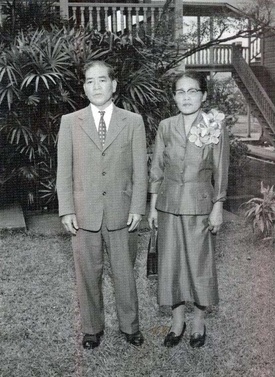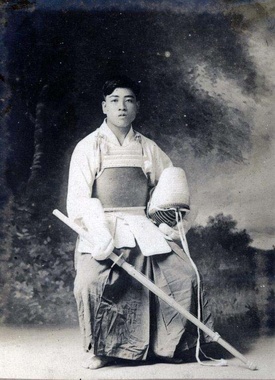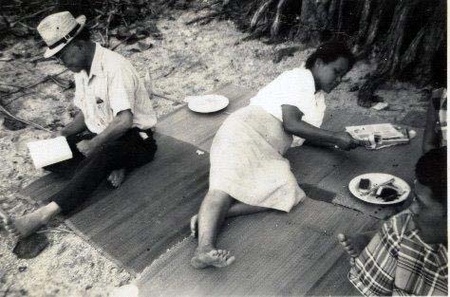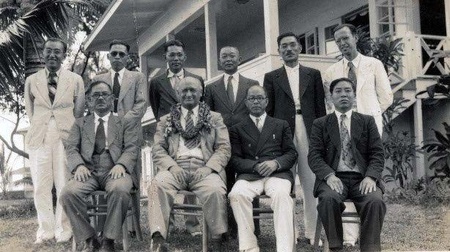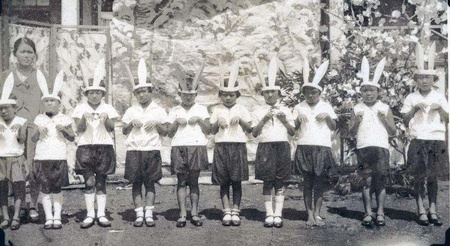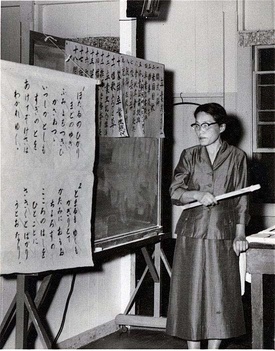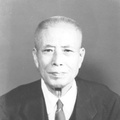It is stated in the “Divine Message of Grand Harmony” by Dr. Masaharu Taniguchi as follows: “Be reconciled with the whole universe. When you are so reconciled the whole universe is your friend. When the whole universe is your friend nothing whatever can harm you.” And he continues, “The greatest among your brothers and sisters are your parents. Those who are grateful to God but cannot be grateful to their parents are against the Divine Will.” There is a Japanese saying to this effect, “that one can never fulfill or repay our debt of gratitude we owe to our parents even if one should continue to strive to do this for his entire lifetime.” And now a reflection of my own Father and Mother.
Our parents were truly remarkable. They never lectured us much but they both taught us courage, perseverance, independence, initiative, and other values by demonstration and practicing these values. In most cases they allowed us to make choices. They had very few material things to give us but were rich in giving us encouragement and to strive for the best and gave us freedom to grow not only physically but in all manners.
Thanks to modern day technology - Ancestry.com – I was able to obtain two significant documents to substantiate some dates. They are: List or Manifest of Alien Passengers for the U.S. Immigration Officer at Port of Arrival, dated Jan. 29, 1907 (on which Grandfather Toyoji and Grandmother Kii are listed) and father’s Selective Service Draft Registration Card and Registrar’s Report dated Oct. 26, 1918.
Looking over these two documents and the family tree, they tell us that father was at least six years old when he returned to Japan to be educated and that he was at least 20 years of age when came back to Hawaii the second time. He is listed as a salesman on his draft registration card. I am not positive but I have a notion that father could have sold Japanese medicines, making house-to-house calls. I always wondered about a container about the size of an attaché case that we had on the shelf which contained drugs as well as other odds and ends.
Photos and certificates indicate that father was trained in martial arts primarily kendo or Japanese fencing, and judo, with some rankings in both arts. I don’t truly realize the significance of the rankings but scrolls signifying his positions were on display at the Bishop Museum in Honolulu. He must have participated in numerous tournaments in both Japan and in Hawaii. He enjoyed the sports, teaching them as well as being a spectator. Although a bit boring to me, I often accompanied dad to some of the tournaments held in Hilo. Brother Yoshiharu and I often were involved in playful judo lessons from father from time to time and we would be tossed about like little twigs or ragdolls.
Father was quite skillful in cabinetmaking as well. Using whatever hand tools that he had, he constructed furniture such as a chest of drawers, wardrobe closets, a study desk for us, and of course, bookcases. He was a great collector of books and we had filled bookcases throughout the house. With the limited tools that were available to him, the pieces of furniture were not of artistic quality but they were functional. He did well in maintaining our home by repairing window screens, replacing screen doors, and the like. Perhaps some power tools were available then but all work performed around our home was by hand tools. Father was quite resourceful and worked with whatever materials were available. Yoshiharu and I once had a monumental task of ripping a piece of redwood about six feet in length which was at least two inches in thickness. The task took us nearly two days to accomplish, and this with painfully blistered hands. We started initially using a crosscut saw but after the first day, we decided on purchasing a rip saw from Keaau Store, on credit of course, and without asking our father. With the proper tool we were able to accomplish our task more readily.
It seems like father was always preoccupied with one thing or another. When the family was still of a manageable size, perhaps difficult to determine, our parents managed to take us to the beach. Mother often prepared the family some sandwiches or at times we stopped by a delicatessen in Waiakea Town for a box-full of cone sushi. We all had a memorable and wonderful time usually at Onekahakaha Beach or more commonly known as “three mile half beach.” Father and Mother themselves never swam or got themselves wet in the water, therefore we children did not learn to swim at all or at least not while we were growing up.
Both of my parents were on the staff of Ola’a Hongwanji Japanese Language School as teachers for as long as I can remember up to the outbreak of World War II. Classes were held in two sessions with elementary grades from first to sixth graders meeting for the first session from 2:30 to 3:30 and the intermediate group from seventh through ninth graders for the second session from 4:00 to 5:00 p.m. from Monday through Friday. Classes on character building were held on Saturdays and they generally ran for two hours in the morning. Saturday was also reserved for campus clean-up where students were involved in cleaning the classrooms, the outhouses, and the school grounds.
Father was also involved in conducting kendo lessons twice weekly in the evenings and in addition he met with adult education Japanese language classes for evening classes as well. He also wrote articles for one of the Hilo Japanese language paper covering local events. Since he was generally free in the morning hours, he worked with an insurance agent selling life insurance and was working toward his insurance agency license when the war came about. According to Uncle Richard, Father was doing well in his insurance venture.
Mother to begin with was not a very healthy person. We were told that she contracted rheumatic fever earlier in her life and as a result, the disease caused damage to her heart. According to doctor’s advice, she was not to have any children; but yet she bore nine of us. She suffered from irregular heartbeat, countless allergic reactions, severe case of varicose veins and she spent quite a bit of her time in bed. In spite of all her physical maladies, she had so much strength and determination and gave little attention for her personal welfare. She enjoyed her teaching career immensely and she continued working with children until she was too ill to teach.
Finance was never a topic of discussion; but I assume that their salaries or compensations were very meager. We all survived but life was certainly not one of luxury. Mother very well demonstrated her ingenuity, resourcefulness, thrift, and perseverance. Our large storage was just filled with “junk” from corner to corner. It was mother’s sewing room and also her craft center. This room was her treasure trove. It was just plain “junk” to us but she had uses for all the items that she refused to discard- Items such as discarded cartons, cardboard pieces, bits of fabric, lauhala leaves, wrapping and packing material, etc., filled the storage.
There were many fabrications and items she created but she was noted for her lauhala house slippers that she crafted and gave away to friends and relatives as gifts. She made alterations to clothing especially children’s so that outfits could be passed on to the younger generation. I ended up wearing woolen shorts to school--a fabrication from dad’s old trousers. (Imagine an elementary school youngster in woolen wear.) Mother never did purchase clothing for herself but generally they were “hand me downers” from Aunty Eleanor.
None of the children’s birthdays were observed with birthday cakes or presents; but each family member was treated either with a bar of candy or ice cream treat of some sort. The birthday celebrant had a pick of his or her choice first. (Don’t remember if we sang the birthday song.) Speaking of presents, the family did not celebrate Christmas; hence, there was no exchange of gifts for the Yule Season until our adulthood.
Sad to say, as the family grew our parents literally had very limited leisure time of their own. For mother especially, aside from her class preparations, she was entangled with “tons” of laundry and other household chores and her day’s work was not complete until very late at night. It was almost my nightly chore to assist mother in pinning her laundry for the day on the clothes line strung in the basement using a kerosene lantern. So often it was nightfall by the time our parents came home from school, way past the usual dinner time. At some point, this was even before the war; mother realized that she could not contend with the volume of the family laundry, that it was deemed necessary to purchase a washing machine and an almost commercial type ironer. (These pieces of equipment will play a vital role in the future.)
With my mother’s heavy work load and schedule, invariably she found it necessary to seek assistance from family members and friends. Very early in our lives Aunty Motoko and Aunty Masayo cared for Kaoru and me. Later on it was Grandma Kii that filled the niche for a number of years. She generally came to care for the children before our parents left for school and prepared dinner for the family. On my return from language school, Grandmother returned to her home to be with Grandfather, Motoko, and Masayo. This was to be a routine for many years until Aunty Motoko was married to Uncle Kanno. From this point on, Mother got the assistance of Mrs. Shinchi, a widow, and her two daughters to care for our family until the coming of the war.
Mother always made certain that we had an adequate supply of food in the house. This was certainly an age before big box stores such as Costco or Walmart made their appearance, but mother was in a habit of purchasing household supplies and food in bulk. She purchased bar laundry soap by the case, canned food such as Spam, tomato packed sardines, and Skippy peanut butter also by the case.
The most common food item in those days was the good old red and white labeled Carnation evaporated milk. We practically grew up on the Carnation product. Mother was always on the look-out for premiums. We certainly consumed a large quantity of cooking cereal. Mother did not invest in any set of dishes because the cartons of cereal she purchased contained a dinner dish, a soup bowl or some other dinnerware. My siblings and I were always eager to open up these boxes to see what dinnerware they contained.
From time to time, Hilo Electric Light Co. sponsored home cooking demonstrations. Mother eagerly attended these sessions and we were the beneficiaries. She would come home and try out the lessons in her kitchen. She prepared delicacies such as Swiss steak, beef stew with dumplings, and the like. The family certainly enjoyed the food and Mother thoroughly enjoyed attending these sessions. I for one was free to explore in the kitchen.
A few of my try-outs in the kitchen were my first try, burnt sugar cake, later spice cake, and devil food cake. My encounters in the kitchen provided me lessons in following directions, and also early lessons in fractions. The thing was no one told me to do this but I exercised my free will at about age 10 or 11, and baked because I wanted to. I just thumbed through Mother’s recipe books and tried things out.
One Thanksgiving Day I roasted a chicken for the family (I must have been about 12 or 13). Why chicken instead of turkey? We simply did not have turkey and it was not available in the local stores. Our chicken on the table was home grown and I went through the whole process of preparation for its use. It was grandma who taught me all this, from killing the chicken, bleeding, feathering, singeing, and finally gutting the chicken. The hen usually got spared because they provided us with eggs; so if chicken was on the menu, it was the rooster that got the “hatchet.”
*This article is an excerpt from Our Nostalgic Heritage: Growing up in a Place Once Called Ola'a (2014) from pages 137 - 141.
© 2014 Akinori Imai


